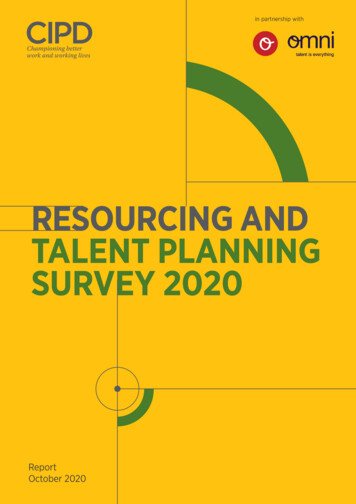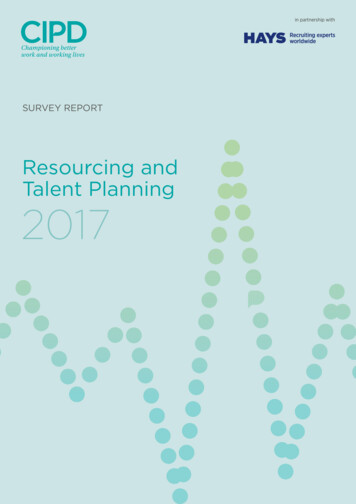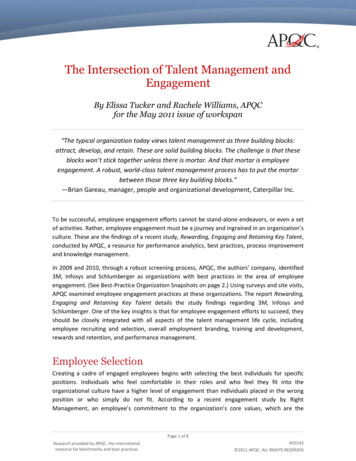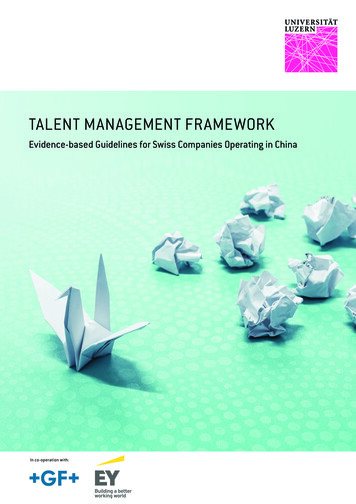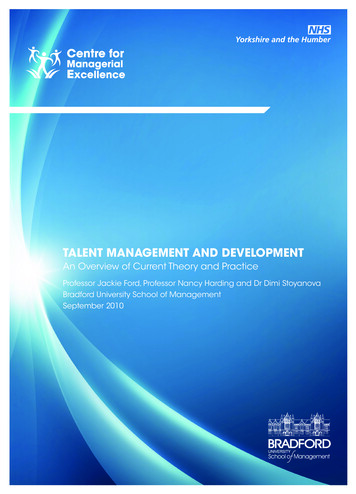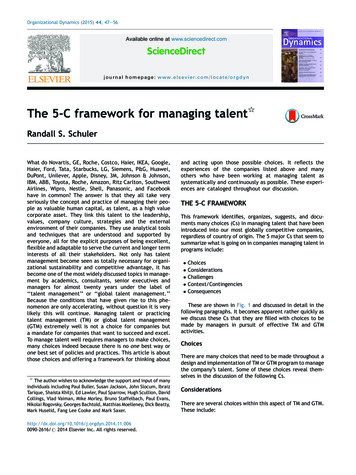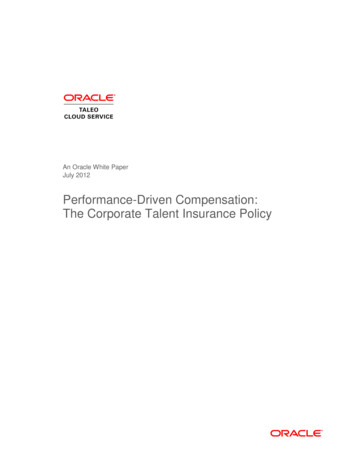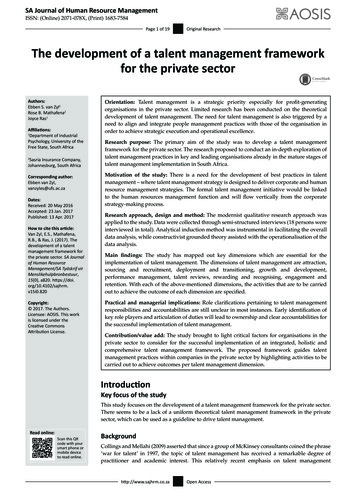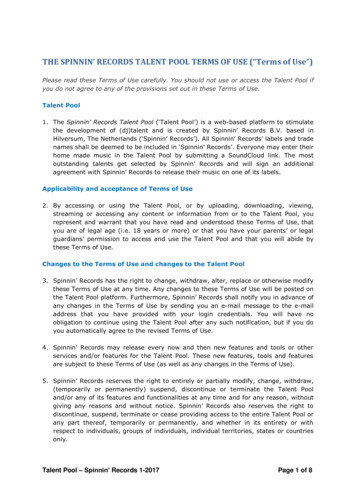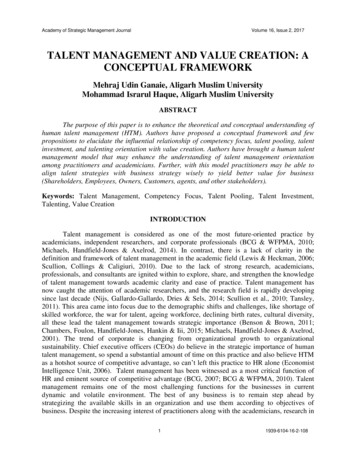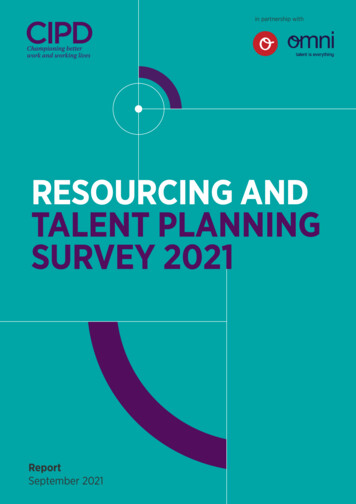
Transcription
in partnership withRESOURCING ANDTALENT PLANNINGSURVEY 2021ReportSeptember 2021
The CIPD is the professional body for HR and people development.The registered charity champions better work and working livesand has been setting the benchmark for excellence in people andorganisation development for more than 100 years. It has more than160,000 members across the world, provides thought leadershipthrough independent research on the world of work, and offersprofessional training and accreditation for those working in HR andlearning and development.The CIPD’s Resourcing and talent planning survey, in partnership withOmni RMS, examines resourcing and talent planning practices and thekey challenges organisations are facing. It provides people professionalsand their organisations with benchmarking data on important areassuch as recruitment costs, workforce planning and retention. Thissurvey was conducted online in May 2021 by YouGov. In total, 1,018UK-based HR/people professionals responded to the survey.
Resourcing and talent planning survey 20211234ReportResourcing and talent planningsurvey 2021Contents1CIPD foreword22Omni foreword33Summary of key findings54Resourcing and talent practices in the current climate105Recruiting: the numbers146Attraction strategies187Selection processes258Recruitment difficulties309Talent management and retention3210Workforce planning3411Background to the survey37567891011AcknowledgementsThe CIPD and Omni are incredibly grateful to the organisations and individuals who gavetheir time and expertise to provide feedback to help inform this report. These include: Rachel Bennett, Director of People Services, Longhurst GroupAnnette Canning, Strategic Lead – People Partnering, EnableNY, North Yorkshire PoliceMatt Eyre, Candidate Marketing Manager, The Co-opDanny Matthews, Apprenticeship & Community Resourcing Lead, The Co-opManjuri Sinha, Global Head of Talent Acquisition, OLX GroupSarah Thorne, COO, The Return HubKerry West, Talent and Development Manager, EnableNY, North Yorkshire PoliceThanks also to Annette Hogarth, research consultant, for analysing the findings and writingthe report.Publication informationWhen citing this report, please use the following citation:1CIPD. (2021) Resourcing and talent planning survey 2021. London: Chartered Institute ofPersonnel and Development.
Resourcing and talent planning survey 202112345678910111CIPD forewordThe CIPD’s Resourcing and talent planning survey, in partnership with Omni, is now in itstwenty-second year. It is a valued survey with a sample this year of over 1,000 UK-basedHR professionals.This year’s survey went live in May 2021 as the UK was starting to emerge from its thirdCOVID-19 lockdown and just over four months after the Brexit transition period ended.It explores the impact of COVID-19 and leaving the EU on resourcing activities as well asongoing trends in resourcing practices and challenges. A number of key themes emergedthis year.Navigating the challenges of the pandemicThe pandemic has had a widespread impact on organisations and the workforce.Two-fifths have had furloughed workers, just over a fifth of organisations have maderedundancies, and many more have reduced working hours, put recruitment activityon hold and/or decreased recruitment in response. Recruitment difficulties have alsobeen exacerbated by the pandemic. More than a quarter report logistical challengesin facilitating socially distanced recruitment processes, while almost a third facedchallenges onboarding new hires.Yet competition for talent continues Despite the impact of the pandemic and growth in unemployment, almost half ofemployers believe that competition for well-qualified talent has increased over thepast year, and a similar number of employers who attempted to recruit had difficultiesattracting suitable candidates. A quarter of organisations also report it is more difficult torecruit employees as a consequence of leaving the EU.The labour market has changed dramatically in recent months, and we are now seeing agrowing crisis in hiring, with very significant skills and talent gaps across many roles.Attracting returners, focusing on flexible working and work–life balanceSome of the strategies organisations are adopting to attract new employees includeappealing to experienced workers through career-returner programmes and mid-careerchange programmes, which have both increased compared with last year. We are alsoseeing a growing focus on flexible working and work–life balance, with a high proportionof organisations advertising at least some vacancies as ‘open to flexible working’ andover half offering greater work flexibility and improved work–life balance to address bothrecruitment and retention difficulties.Carrying over from last year, it continues to be the case that organisations could be moreproactive in their efforts to attract and recruit diverse candidates, especially at board level.Too many organisations taking an ad hoc approach to recruitmentMore than two-fifths of organisations say they take an ad hoc approach to recruitmentand less than half have a workforce planning strategy based on a robust understandingof current and future workforce needs. Most organisations are also not taking a robustapproach to collecting data to inform resourcing decisions. Just over a third collect datato identify skills gaps within their organisation and less than a third to identify future skillrequirements.Taking a more strategic, joined-up approach to recruitment and talent managementactivities will help organisations to get to grips with their existing talent profile and2CIPD foreword
Resourcing and talent planning survey 20211234their current and future requirements. Collecting and evaluating data, and strengtheningapproaches based on the insights gained, are essential for supporting the effectivenessand efficiency of resourcing strategies.More focus needed on talent management and retentionFinally, organisations’ focus on talent management has fallen during the pandemic andfewer organisations undertook specific initiatives to improve employee retention in the last12 months compared with previous years. Even in organisations that reported talent wasincreasingly difficult to retain, only two-fifths had undertaken retention initiatives.As the economy improves and recruitment and talent management budgets also farebetter, it will be important for organisations to place greater focus on these key areas tohelp support their post-pandemic recovery.56Claire McCartney,Senior PolicyAdviser, Resourcingand Inclusion78291011 Omni forewordWe are pleased to partner with the CIPD for the second year to produce this reportthat provides invaluable insight into resourcing and talent planning trends. The findingsand recommendations are crucial for employers and talent professionals navigating thechallenges and implementing talent strategies in a world that looks very different fromwhat it did 12 months ago.Acute talent shortagePrior to the pandemic, the UK economic outlook was positive, despite uncertainty overBrexit. The nation had reached its lowest levels of unemployment since the 1970s, and fewcould predict how our world would change in a matter of months. But a year on from thelast report, it’s become equally hard to believe that just over 12 months ago, economistswere predicting unemployment to rise to over 13%. The furlough scheme undoubtedlyhelped prevent this from happening, with almost 9 million jobs furloughed at its peak.And what a difference a year makes. This latest report is released during what is provingto be a ‘perfect storm’. The delayed impact of Brexit and the sharp drop in overseasworkers, along with the reopening of the economy, combined to put significant pressureon business operations through acute talent shortage. Indeed, talent availability hasreportedly fallen at the quickest rate on record as unemployment rapidly drops. In themiddle of summer 2021, there was around 4.7% or 1.6 million people unemployed, while inthe third week of August, there were 1.66 million active job adverts in the UK.1The U-shape bounce-back, suggested as a possible outcome following the pandemic,is now evident. This, coupled with the fall in business travel, increased hybrid working,rise in e-commerce and the aforementioned impact of Brexit, leaves us with the highest13Jobs Recovery Tracker: Demand for workers remains high amidst growing worker shortages, REC Press Release, 3 Sep 2021.Omni foreword
Resourcing and talent planning survey 202112345level of labour mismatch in UK history. This is at a critical point in some sectors, such astransport and logistics, and hospitality, manufacturing and construction, where many firmsreport the worst staffing shortages since the 1990s, with genuine issues such as goodsnot getting delivered and restaurants unable to open, to name a few. At the same time,issues creating concern in higher-paid and harder-to-recruit sectors, such as finance, IT,accounting and engineering, include record levels of pay increases, buy-back and counteroffers as employers try whatever it takes to retain and secure the best talent. Somewhatcounterintuitively, this perfect storm puts the UK’s economic recovery at risk.There is debate about whether these pressures will remain in place in the longer term.We are still operating in unpredictable times, and only time will tell how much the end offurlough and greater candidate confidence will help meet the rising demand for talent.The pre-pandemic challenges of IR35, the effects of globalisation, digitalisation, an ageingworkforce, and the dynamics of multi-generational workplaces all also remain.9Report recommendationsGiven the reality that we are lacking the right people with the right skills needed for theeconomy to thrive, this report reveals how companies must adjust their talent strategies tomeet the shifting demands rather than simply reverting to those that served them well inthe past. Businesses need to retain and upskill their workforce and think creatively aboutthe future of work and how to diversify talent. The winners will be those who are reshapingtheir talent strategies now to ensure they continue to attract, develop, and retain the best,and who are applying the same rigour, effort and sophistication to resource planning asto designing overall business strategy. Developing strategic partnerships with providersto offer expertise, agility and pace while maintaining business values and enhancing theemployee value proposition will be critical during these times.10The findings and recommendations in this report give insight into the generally progressivepractices that enable others to learn, plan and be prepared for the challenges ahead.67811Louise Shaw,Director ResourcingTransformation4Omni forewordMartin Wainman,Managing Director
Resourcing and talent planning survey 202112345678910113Summaryof key findings Competition for talent despite reduced recruitment and retention activity COVID-19 has had an abrupt impact onrecruitment activity – 26% of organisations didnot attempt to recruit at all in the last 12 months,compared with just 4% the year before. Amongthose who did attempt to recruit, the mediannumber of permanent (2020: 15; 2019: 30) andshort-term (2020: 3; 2019: 8) vacancies felldramatically in all sectors. However, 21% haveincreased their recruitment activity as a result of the pandemic. Fewer organisations undertook initiatives to improve retention (from 55% the previousyear down to 29%) in a year when 40% furloughed staff, 22% made redundancies and16% reduced working hours. Despite the growth in unemployment during the past year, 45% of respondents believethat competition for well-qualified talent has increased over the period, while just 15%disagree. Nearly half (49%) of employers who attempted to recruit had difficultiesattracting suitable candidates. A quarter of organisations report it is more difficult torecruit staff as a result of Brexit. 30% say that talent is more difficult to retain comparedwith a year ago. Looking forward, growing confidence in the economy is reflected in our findings that29% of organisations anticipate an increase in their recruitment budget for 2021–22,while fewer (13%) anticipate a decrease. Respondents are also more likely to anticipatean increase in their talent management budgets (26%) than a decrease (11%).Implications and recommendations for practitionersWith the reopening of the economy, recruitment activity is accelerating at a significantpace. Despite the rise in unemployment in 2020, many organisations are facingconsiderable recruitment difficulties, particularly in industries that have disproportionatelyrelied on EU migrant workers. The surge in demand for labour caused by the easing ofrestrictions is likely to level off, and ongoing employment growth will depend on how theeconomy recovers from the impact of the pandemic. Nevertheless, organisations may findthemselves facing skill or labour shortages and need to take action to ensure they canaccess, develop and retain the talent they need.1 Take a strategic approach to workforce planning, given both the impact ofimmigration restrictions and the pandemic. A useful first step might be to carry out aworkforce audit, especially for those sectors that are heavily reliant on EU nationals.2 When thinking about recruitment specifically, consider what are the key roles that youneed to recruit for and what would make the biggest difference to your organisation.3 Collect and make good use of resourcing data and evidence to justify spend whenbudgets are limited.4 For those industries affected by a reduction in EU migrant workers, employersshould look to invest in both training and reskilling of domestic workers and buildingcareer pathways and routes into work for young people.5Summary of key findings
Resourcing and talent planning survey 20211234567891011Efforts to develop and update skills A third of organisations report having developedmore talent in-house compared with theprevious year. Upskilling existing employeesis the most common response to recruitmentdifficulties (57%). Nearly half of organisations currently offerapprenticeships and two-fifths offer graduateprogrammes. Around three in ten offercollege-leaver routes or intern schemes – down from nearly two-fifths last year. In contrast, more organisations are attempting to attract experienced workers throughcareer-returner programmes (27%, up from 19%) and mid-career-change programmes(21%, up from 16%).Implications and recommendations for practitionersInvesting in skill development can help organisations maintain a robust talent pipeline,while simultaneously increasing employee engagement and retention. It is encouraging tosee increasing efforts to attract experienced individuals back into the workplace throughcareer-returner and mid-career-change programmes, particularly given the context of thepast year. The decline in internships and college-leaver routes may not be surprising giventhe lockdowns and government recommendations to work from home where possible, butwith growing youth unemployment, initiatives that tap into this pool of talent can helporganisations access and grow the skills they need.1 Invest in internal skill development wherever possible – it will support retention and holdyou in a more competitive position as the wider economic picture continues to improve.2 Step up your focus on internal mobility throughout your organisation.3 Develop strategies to attract career-returners and mid-career-changers to helpbroaden your talent pool and diversify people’s skills and experiences.4 Don’t underestimate or make assumptions about the skills your people have and trynot to bound people by their job descriptions.5 Invest in ways for young people to access opportunities in your organisation, suchas through apprenticeships, traineeships, industry placements and post-A-levelroutes, and keep up to date with new products and routes.Increased focus on flexibility and work–life balance 60% of organisations increased homeworking inresponse to the pandemic. 71% of organisations advertise at least somevacancies as ‘open to flexible working’, 49%advertise at least some as ‘open to location’, and27% are recruiting from a wider geography withinthe UK compared with the previous year. 54% are offering greater work flexibility to address recruitment difficulties, a smallincrease on last year.6Summary of key findings
Resourcing and talent planning survey 20211234567 There is an increase in the proportion of employers taking steps to retain employeesthrough improving work–life balance (49%, up from 37% in 2019) and introducing orenhancing flexible working options (48%, up from 43% in 2019).Implications and recommendations for practitionersEmployers are recognising the growing importance of flexible working to employees.Flexible working arrangements enable organisations to access a wider segment of thelabour market, including people who may not want or be able to work regular 9-to-5 hoursor at a particular location. Building in flexible working arrangements is not only goodfor inclusion but supports work–life balance, wellbeing, job satisfaction and loyalty byempowering people to have greater control in their working life.CIPD survey findings indicate a big shift by organisations when it comes to flexibility withlocation but less of a focus on other forms of flexible working which allow flexibility overhours. This brings with it the risk of a two-tier workforce, where some can benefit fromhomeworking and the flexibility that provides, while many workers need to continue toattend their place of work and are afforded little flexibility.1 Use the tagline ‘happy to talk flexible working’ when recruiting, wherever possible.82 Support the CIPD’s #FlexFrom1st campaign and make the right to request flexibleworking a day 1 right within your organisation to support fairness and to open upopportunities more broadly.93 Consider a hybrid approach to working in the future, if your industry, organisationand job roles can support some remote working.104 Review your flexible working policies and practices to ensure they are fit forpurpose and afford choice. What have you learned about flexible working from thepandemic period? What might you do differently now?115 Engage senior sponsors within your organisation who can role-model and supportflexible working.6 Do you offer flexibility in hours (such as compressed hours, job-sharing orstaggered start and finish times) as well as location? This is particularly importantfor the substantial number of employees who are unable to work remotely andneed to attend their physical place of work.More employers have a formal diversity policy, but work is still needed inattracting and recruiting diverse candidates There is an increase in the proportion oforganisations with a formal diversity policy (62%,up from 52% in 2020), although most could takea more proactive and comprehensive approach toattracting and recruiting diverse candidates. 24% of organisations that attempted to fillvacancies report they recruited a more diverseworkforce over the last 12 months compared with the previous year. Our findings show considerable variation in efforts to attract diverse candidates to boardlevel. A quarter (25%) of organisations are very or extremely active in their efforts to recruitmore diverse candidates to the board, while a similar proportion are not at all active.7Summary of key findings
Resourcing and talent planning survey 2021123Implications and recommendations for practitionersWhile it is encouraging to see an increase in diversity policies, good words and intentionswill be seen as lip-service without action and results. Systemic change requires acomprehensive assessment of policies and processes that limit or deter inclusion anddiversity and also collective ownership throughout the organisation. The role of linemanagers involved in hiring decisions is critical, but currently just 68% of organisationsreport their line managers follow objective assessment and scoring criteria when recruiting,while just over half (54%) provide them with recruitment training.41 Diversify your recruitment outreach and place more rigour, consistency andchallenge in your recruitment and selection procedures.52 Ensure line managers and all involved in hiring decisions have had recruitmenttraining and follow objective, structured assessment and selection processes thathave been designed to maximise fairness, minimise adverse impact on differentcandidate groups, and include predictive assessment criteria, anchored rating scaleand multiple assessors.678910113 Build a strategic and proactive approach to attracting and developing diversecandidates to fill senior positions. Engage senior sponsors to help communicate andcommit to this strategy.4 Critically review your end-to-end candidate experience with a diversity lens,ensuring that the entire process is accessible to all and represents your diversityobjectives.5 Critically evaluate your organisation brand (including a review of your online/socialmedia presence) to see how attractive it is to diverse candidates. What changes canyou make to your brand and your culture to help attract, select, develop and retainmore-diverse employees?6 Evaluate your recruitment activities to assess which are most effective in diversifyingyour talent pools and prepare your organisations that there might need to be atrade-off between reaching greater diversity and increasing time to hire.Use of recruitment technology is limited by internal skills and resources Fewer organisations report they used recruitmenttechnologies last year in line with the decline inrecruitment activity. Three-quarters of those whodid use technology in recruitment report theiruse has increased due to the pandemic – 26% toa great extent. Overall, 54% use video interviews, 28%online induction processes, 27% online tests/assessments, 24% applicant tracking systems, and 20% onboarding platforms. Feworganisations use artificial intelligence (AI) or machine learning in recruitment processes. Those using technology report a number of benefits, the most common beingincreased accessibility for candidates, although for some this meant increasedapplications from unsuitable as well as suitable candidates. 37% report the use oftechnology has helped reduce unconscious bias (to some or a great extent). These8Summary of key findings
Resourcing and talent planning survey 2021123456organisations are more likely to report that technology has also increased the diversityand quality of their hires. Nearly two-thirds report it has sped up the recruitmentprocess at least to a small extent. More than half, however, report their use of technology has been limited by a lack ofinternal skills and knowledge and/or resources.Implications and recommendations for practitionersNearly a third of organisations who attempted to recruit last year report an excessivenumber of applicants to process and nearly two-fifths report receiving more unsuitableapplicants for each post compared with the previous year. As in previous years, however,only 14% use tools to enable self-selection. Considered use of appropriate technologiescan help organisations process high volumes of applicants efficiently, while simultaneouslyimproving the candidate experience and the quality and diversity of hires.Technology should not be implemented for its own sake, but our findings suggest thatthere is considerable scope for more effective use of technologies in recruitment. Peopleprofessionals need to ensure technologies adopted meet the needs of the organisation,have been robustly tested, and provide a fair and inclusive candidate experience.78910111 Assess your internal capability and resource around recruitment technology, upskilland further invest, where necessary.2 Ensure any recruitment technology adopted meets the needs of your organisationand provides a fair and inclusive candidate experience.3 Continue to evaluate and improve your use of technology. Ask candidates andhiring managers for feedback and act on that feedback. Provide feedback tocandidates where possible.4 Review the impact of your use of technology in recruitment on the diversity of yourhires and the number of suitable versus unsuitable candidates for your vacancies.Include checks of any automated rejections to ensure that the criteria being used isnot unintentionally creating barriers to entry for diverse skills-sets.5 Consider making better use of tools to enable self-selection, such as pre-applicationassessments, and technologies such as chatbots to potentially reduce the number ofunsuitable candidates.How strategic are organisations in their approach? 30% of respondents report that their CEO hashad talent management as a key priority over thelast 12 months, down from 48% the previous year. Less than half (46%) of organisations havea workforce planning strategy based on arobust understanding of current and futureworkforce needs. 43% tend to take an ad hocapproach to recruitment. Organisations vary considerably in how far ahead they look when planning and takingaction on current and future workforce requirements. 28% don’t look beyond sixmonths, while only 13% are planning for over three years into the future.9Summary of key findings
Resourcing and talent planning survey 20211234567891011 Few organisations take a comprehensive data-based approach to inform and improvetheir resourcing decisions. Just 23% collect data to forecast hiring demands and13% to assess the availability/supply of talent in the market. 13% measure the returnon investment of their recruitment activities, while 20% calculate the cost of labourturnover and 27% collect data to identify retention issues.Implications and recommendations for practitionersCOVID-19 has forced changes to workplace practices and also workforce demands andexpectations. Now is a good time to review how well the workforce is equipped to meetorganisational goals moving forward and how future skill and labour requirements will bemet. Ongoing reviews and evaluations of existing practices, processes and initiatives willbe crucial in ensuring better decision-making for the needs of the organisation.1 Consider whether your organisation places enough focus on talent management. Isit something that has slipped off the radar during the pandemic? Is there more youcould be doing to prioritise activity here?2 Do you have a workforce planning strategy or does your approach to recruitmenttend to be more ad hoc? Could you develop a more strategic, planful approach?3 Consider forming a cross-company committee to help inform your approach toworkforce planning.4 Focus on talent intelligence and consider automating basic administrative activitieslike interview scheduling.5 Take a comprehensive, data-based approach to improving all your resourcing decisions.Collect and evaluate data and strengthen approaches based on the insights gained.4Resourcingand talent practices in the current climateKey findings 28% of organisations put recruitment on hold and 16% reduced recruitment activitybecause of the pandemic. 40% have furloughed staff, 22% made redundancies and16% have reduced working hours. For 21%, however, the pandemic has resulted inincreased recruitment activity and 11% have increased working hours. 60% of organisations have increased homeworking and 27% have redeployedstaff to different roles in response to the pandemic, yet just 12% report theyhave increased training. A quarter of organisations say it is more difficult to recruit staff due to the UKleaving the EU. Just over a fifth report they are reducing their use of contractors due to IR35 legislation. 45% of respondents believe that competition for well-qualified talent has increasedover the past year while just 15% disagree. Views on whether talent is more difficultto retain are more divided, with 30% agreeing and 28% disagreeing.10Resourcing and talent practices in the current climate
Resourcing and talent planning survey 20211234567891011Impact of COVID-19 on resourcing activityThis survey was conducted in May 2021 as the UK began to emerge from its third COVID-19lockdown. Figure 1 shows the widespread impact of the pandemic on organisations and theworkforce. Two-fifths have furloughed workers through the UK Government’s Coronavirus JobRetention Scheme (CJRS), but even with this support, 25% of the private sector have maderedundancies (19% of non-profits and 10% of the public sector) and many more have reducedworking hours, put recruitment activity on hold and/or decreased recruitment in response. Overall,5% say they had to temporarily close their business (12% of voluntary sector organisations).While the pandemic has resulted in reduced business activity in many sectors, for some,particularly those operating essential services, it has had the opposite effect. Nearly a third(32%) of public sector organisations (19% of the private sector and 21% of non-profits) haveincreased recruitment in response to the pandemic and 20% have increased working hoursfor staff (9% of the private sector and 14% of non-profits).Three-fifths of organisations adapted by increasing levels of homeworking, and larger organisationsin particular redeployed staff to different roles. Despite the new ways of working, just 12% increasedtraining in response to the pandemic and 11% increased their focus on retaining talent.Requesting proof of COVID vaccinationAt the time of the survey the Government was running a review to consider whether tointroduce a vaccine certificate or passport system, and as part of this whether employerscan request proof of vaccination. Twelve per cent of respondents expected their organisationto ask for proof of a COVID vaccination when recruiting new employees in the future(68% didn’t, 20% don’t know). Asking candidates
Kerry West, Talent and Development Manager, EnableNY, North Yorkshire Police Thanks also to Annette Hogarth, research consultant, for analysing the findings and writing the report. Publication information When citing this report, please use the following citation: CIPD. (2021) Resourcing and talent planning survey 2021. London: Chartered .
